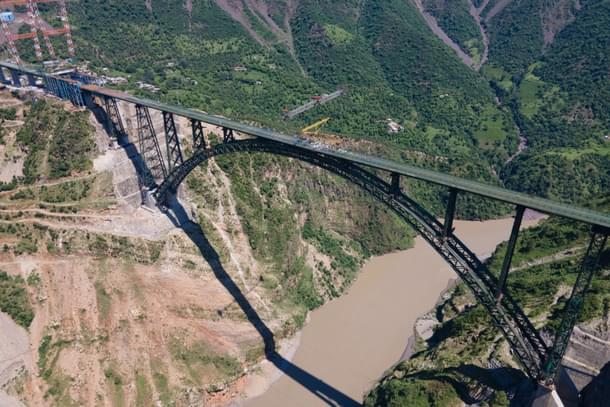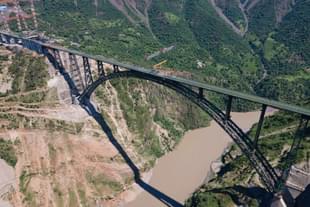Infrastructure
Chenab Bridge: Train Services To Begin On World's Highest Rail Bridge From 15 August
V Bhagya Subhashini
Jul 19, 2024, 02:21 PM | Updated 02:20 PM IST
Save & read from anywhere!
Bookmark stories for easy access on any device or the Swarajya app.


Indian Railways prepares to launch train service between Reasi and Sangaldan, traversing the world’s highest rail bridge over Chenab river.
Efforts are underway to commence this much-anticipated service on 15 August.
The arch bridge, situated between Bakkal and Kauri in the Reasi district, creates a vital link between Katra and Banihal.
The 1,315-metre (m) Chenab bridge is a critical component of the Rs 35,000 crore Udhampur-Srinagar-Baramulla Rail Link (USBRL) project, which aims to improve connectivity in Jammu and Kashmir.
Following an extensive inspection of the newly-constructed Chenab Bridge, the world's highest rail bridge, railways successfully conducted a trial run of an eight-coach MEMU train between Sangaldan in Ramban district and Reasi at a speed of 40 kmph last month, reports Deccan Herald.
The Rs 14,000 crore-worth Chenab Bridge stands 359 m (around 1,178 feet) over the Chenab River, making it 35 m taller than the Eiffel Tower in Paris, France.
The bridge is designed to withstand winds of up to 260 kilometres (km) per hour and is expected to have a shelf life of around 120 years. It has a 20.15 km-long approach road and is earthquake-resistant.
Notably, Indian Railways has implemented a comprehensive safety measure to minimise the potential impact of a bomb blast on the bridge. A 780-m-long blast protection platform, a first in India's rail sector, will feature on the bridge's surface to absorb explosion impact during train operations.
The protection platform is positioned on both sides of the track on the bridge, comprising 165 steel decks, some measuring 17 m in length and the rest 13.5 m.
The bridge construction process involved excavating about 12 lakh cubic metres of earth. Globally renowned tunnelling experts are contributing to the tunnelling works underway in the section.
The sophisticated Tekla software has been deployed for structural detailing using structural steel suitable for temperatures between -10 degrees Celsius and 40 degrees Celsius.
As part of the smart asset management system, 120 sensors are installed as part of the structural health monitoring system for the Chenab arch bridge. These sensors operate round the clock and provide essential real-time data on various factors like wind velocity, temperature, humidity, and vibrations.
The construction of the bridge entailed the fabrication of 28,660 metric tonnes of steel, 10 lakh cubic metres of earthwork, 66,000 cubic metres of concrete, and the construction of 26 km of motorable roads.
The project required the collective efforts of more than 1,300 workers and 300 engineers.
For the people of Jammu and Kashmir, the bridge represents the culmination of a two-decade wait since its first approval in 2003.
Once the USBRL project becomes fully operational, a Vande Bharat Metro train will run between Jammu and Srinagar, further enhancing connectivity.
The inauguration of this service is set to significantly improve economic and social integration for the people of Jammu and Kashmir.
V Bhagya Subhashini is a staff writer at Swarajya. She tracks infrastructure developments.




